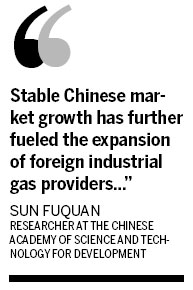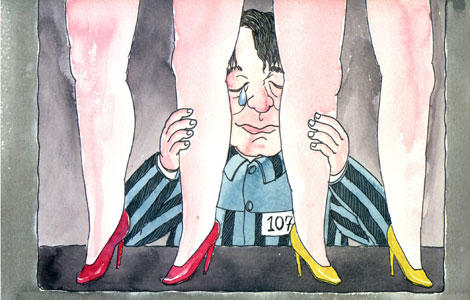French gas maker airs investment plan
Updated: 2013-07-19 07:32
By Zhong Nan (China Daily)
|
|||||||||||
Air Liquide Group, the world's largest industrial gas producer by revenue, is launching the second phase of its Tengfei II investment plan in China this year, to meet growing demand for oxygen, nitrogen, hydrogen and other gases.
The French company launched Tengfei I in 2007. It decided to invest 300 million euros ($393.6 million) and recruit 500 new staff each year in the mainland market. It now has 4,000 employees operating 64 plants in 16 provinces.
Remi Charachon, president of Air Liquide (China) Holding Co Ltd, said the Tengfei II program will run through 2020, with investment at the same or higher level each year. The company will pay special attention to the West and Northwest regions.
The investment will be used to expand manufacturing facilities, on-site production, technology research, medical gas supply networks and Chinese companies' outsourcing production of non-core products.
Industrial gases and related technology are crucial in many industries. Examples include healthcare, such as medical oxygen and anesthetic gas, clean-energy and high-tech industries such as advanced coal gasification, metallurgy, chemicals, petrochemicals, vehicles, food and pharmaceuticals, which are among China's top development priorities.

"China's policies to cut greenhouse gas emissions and improve energy efficiency offer industrial gas makers great opportunities for rapid growth in the world's second-largest economy," said Charachon.
In the past two decades, China's inexpensive labor force and resources have supported its manufacturing boom, but at the cost of low profits, heavy pollution and increased energy use.
After realizing that these outcomes will only make its economic growth slow and unsustainable, the Chinese government has vowed to cut carbon emissions for each unit of GDP by 17 percent by 2015, set against 2010 levels.
Coal-fired power plants, petrochemical companies and steel and cement producers are moving to cut emissions to avoid losing access to bank loans or having their operating licenses revoked by the government.
"Under such circumstances, China is seeking high-level technologies to produce gasoline with lower sulfur," Charachon said.
"There are huge projects linked to energy, transforming coal into gasoline or diesel, that require huge volumes of oxygen, but also some other technology to transform coal into syngas, which will be used in the process of producing gasoline or diesel."
Sun Fuquan, a researcher at the Chinese Academy of Science and Technology for Development in Beijing, said the demand for industrial gases will continue to surge over the next decade due to the rapid development of China's healthcare, electronics, photovoltaic, engineering, environmental and urbanization-related industries.
China has become a big buyer of these invisible air gases in recent years. It consumed 76 billion yuan ($12.4 billion) of industrial gases last year. The China Industrial Gas Association has forecast that China's demand for industrial gases would hit $15.94 billion in 2016.
"Stable Chinese market growth has further fueled the expansion of foreign industrial gas providers such as France's Air Liquide SA, Germany's Linde AG and the US-based companies Praxair, Air Products and Chemicals Inc in China," Sun said.
"They have sophisticated technology to produce high-quality gases and set long-term product goals for energy, water and chemical use."
Even though Chinese gas makers dominate the domestic market, Chinese companies are still not fully competitive. They cannot make high-capacity air separation units.
Such units require the import of key components and strong technological and operational know-how.
Air Liquide, which operates in 80 countries, posted 1.6 billion euros of net profit in 2012, up from 1.53 billion euros a year earlier.
Related Stories
China's gas price hike 'positive' for companies 2013-07-09 11:19
Industry to pay 15% more for natural gas 2013-06-29 02:48
China steps up search for gas 2013-06-21 07:31
CNPC building China's first shale gas pipeline 2013-06-19 21:11
E&Y reports risks, opportunities in oil, gas sector 2013-06-18 07:23
Today's Top News
China's government spends less in 2012
Obama weighs canceling Moscow talks with Putin
Xi hails closer cooperation with Switzerland
Yuan: Collateral types to expand
Overall home price rise softens
'Downside risk can be managed'
Detroit files biggest ever US municipal bankruptcy
Mandela turns 95 in hospital bed
Hot Topics
Lunar probe , China growth forecasts, Emission rules get tougher, China seen through 'colored lens', International board,
Editor's Picks

|

|

|

|

|

|





